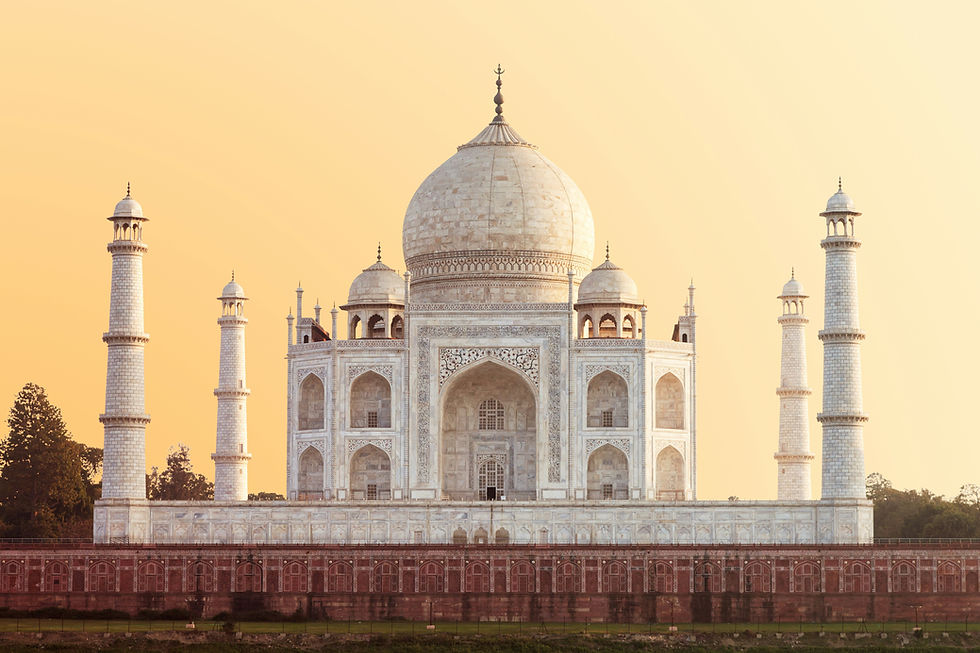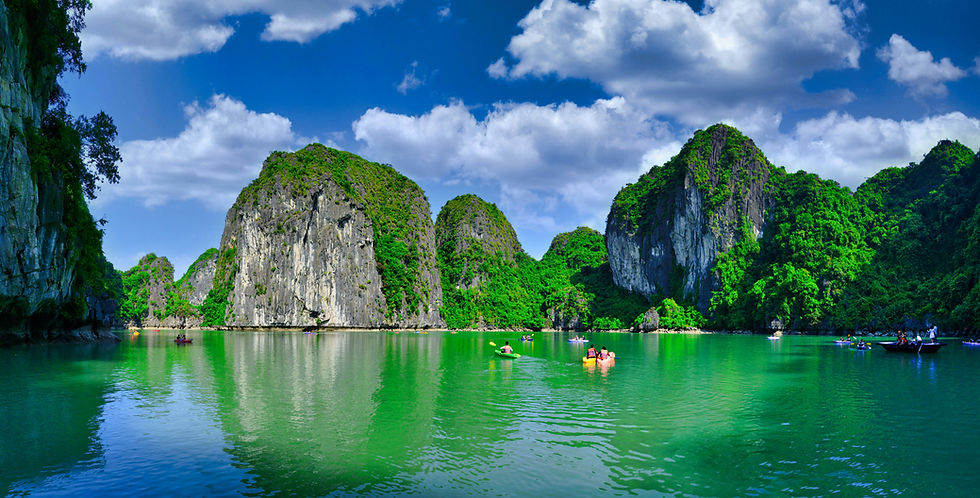5 Extraordinary UNESCO World Heritage Sites in Asia Worth the Journey
- Britta Roper

- Jun 24
- 5 min read
Updated: Oct 22
Where ancient temples meet marble masterpieces and limestone karsts rise from emerald waters.
There are journeys that stay with you long after you've returned home—not because of where you went, but because of what you witnessed. Moments when you stand before something so extraordinary that the rest of the world falls away. When history, artistry, and human achievement converge in ways that take your breath.
Asia's UNESCO World Heritage Sites offer these transformative encounters. From marble monuments that shimmer at sunrise to jungle temples reclaimed by enormous tree roots, from volcanic landscapes dotted with stupas to limestone islands rising from jade-green seas—these are places that remind us why we travel in the first place.
The Taj Mahal: Poetry Written in Marble

The Taj Mahal isn't simply a monument—it's an eternal love letter rendered in white marble. Built in the 17th century by Mughal Emperor Shah Jahan for his beloved wife Mumtaz Mahal, this architectural masterpiece dazzles with intricate pietra dura inlays, reflecting pools that mirror its perfect symmetry, and shifting colors that transform from soft pink at sunrise to luminous gold at dusk.
It may seem almost too obvious to include, but the Taj is iconic for a reason. Its scale, artistry, and emotional resonance create an experience that transcends photography. Standing before it as dawn light illuminates the dome, you understand why this monument has captivated travelers for nearly four centuries.
The surrounding complex rewards deeper exploration: the red sandstone mosque, the elegant gardens designed in the Persian charbagh style, the Yamuna River views from behind the monument. A private guide can reveal the symbolism embedded in every detail—from the calligraphy that adorns the entrance to the optical illusions that make the minarets appear perfectly vertical.
Where to Stay: The Oberoi Amarvilas in Agra places you just 600 meters from the Taj Mahal, with every room offering unobstructed views of the monument. Arrive early for sunrise viewing, then return to your terrace for breakfast as the marble glows in morning light.
Kyoto's Sacred Landscapes: Where Tradition Lives

While many cities preserved their past in museums, Kyoto simply continued living it. This former imperial capital shelters seventeen UNESCO-designated properties—temples, shrines, and castles that have shaped Japanese aesthetics and spirituality for over a millennium.
Kinkaku-ji, the Golden Pavilion, floats on its reflecting pond like a meditation on impermanence and beauty. Ryoan-ji's enigmatic rock garden invites contemplation—fifteen stones arranged in raked gravel, their meaning debated for centuries. Fushimi Inari's thousands of vermillion torii gates create tunnels of light ascending the mountainside.
But Kyoto's magic extends beyond its monuments. It's in the geisha districts where centuries-old wooden machiya houses line narrow lanes. In the kaiseki restaurants where seasonal ingredients become edible art. In the tea ceremonies where every gesture carries meaning refined over generations.
Spring brings cherry blossoms that transform temple gardens into clouds of pink and white. Autumn paints the maple trees in shades of crimson and gold. Each season offers its own revelations.
Where to Stay: Traditional ryokans like Tawaraya or Hiiragiya have welcomed travelers for centuries, offering tatami rooms, kaiseki dinners, and the kind of hospitality that feels like an art form. For contemporary luxury with traditional soul, Aman Kyoto nestles in a secret garden north of the city, with private onsen overlooking forested hillsides.
Ha Long Bay: Where Dragons Descend to the Sea
Vietnamese legend tells of dragons that descended from the mountains to protect the coast, their thrashing tails carving valleys that filled with water. Whether you believe the myth or the geology, Ha Long Bay's 1,600 limestone islands rising from emerald waters create one of nature's most surreal landscapes.
These karst formations—some barely larger than a house, others concealing caves and grottoes—have been sculpted by wind and waves over millions of years. Sail between them at dawn when mist clings to the stone pillars, and the bay feels like a Chinese scroll painting come to life.

The best way to experience Ha Long Bay is by water, and luxury cruise options have evolved dramatically. Multi-day itineraries allow time to kayak through sea caves, visit floating fishing villages, practice tai chi on the sundeck at sunrise, and explore Sung Sot Cave with its cathedral-like chambers.
Where to Cruise: Heritage Line's Ylang and Bhaya Cruises' Alisa Premier offer intimate vessels with spacious suites, outdoor jacuzzis, and curated excursions. For the ultimate indulgence, Paradise Elegance features butler service, private balconies, and Michelin-level dining as limestone karsts drift past your window.
Borobudur: A Meditation in Stone
Rising from the lush Javanese landscape like a cosmic mountain, Borobudur is the world's largest Buddhist monument—nine stacked platforms adorned with 2,672 relief panels and 504 Buddha statues. Built in the 9th century and mysteriously abandoned centuries later, it lay hidden beneath volcanic ash and jungle growth until its rediscovery in the 1800s.

Walking the monument is designed as a spiritual journey. You begin at the base, where reliefs depict the realm of desire—the earthly world of attachment and suffering. As you ascend through galleries, the carvings trace the path to enlightenment. At the summit, 72 stupas encircle a central dome, each containing a Buddha figure visible through latticed stonework.
From here, you see the volcanic peaks that frame the horizon—Mount Merapi and Mount Merbabu—creating a landscape that has inspired contemplation for over a millennium.
Visit at dawn when mist swirls around the temple base and the first light illuminates the stupas. The experience becomes meditative, almost otherworldly, as you climb in near-silence while the surrounding jungle awakens.
Where to Stay: Guests at Amanjiwo—meaning "peaceful soul"—enjoy private sunrise access to Borobudur before the site opens to the public. The resort's design mirrors the temple's circular structure, with suites overlooking rice paddies and volcanic peaks. Buddhist meditation sessions and traditional Javanese wellness rituals deepen the cultural immersion.
Angkor Wat: Kingdom of Stone and Jungle
The temples of Angkor are more than ruins—they're a civilization frozen in stone. At its height in the 12th century, Angkor was the largest pre-industrial city in the world, a metropolis of nearly a million people. Today, its temples emerge from the jungle like archaeological dreams, their sandstone corridors carved with dancing apsaras and bas-reliefs depicting Hindu epics.
Angkor Wat itself remains the world's largest religious monument, its five towers representing Mount Meru—the center of the universe in Hindu and Buddhist cosmology. But the complex extends far beyond this iconic temple. Ta Prohm captivates with massive tree roots that have consumed doorways and galleries, creating a surreal fusion of architecture and nature. Bayon mesmerizes with its 216 serene stone faces gazing in all directions. Banteay Srei, though smaller, dazzles with intricate carvings so detailed they appear almost lace-like.

The sheer scale requires several days to explore properly. Sunrise at Angkor Wat draws crowds, but sunrise at lesser-known temples like Pre Rup or Srah Srang offers equally magical light with far fewer visitors.
Where to Stay: Amansara, converted from the former guest villa of King Sihanouk, offers understated luxury in Siem Reap with private temple tours, pool suites, and Khmer dining. For ultimate immersion, Belmond La Résidence d'Angkor provides colonial elegance and personalized temple itineraries guided by archaeologists who reveal hidden details invisible to casual visitors.
Experience UNESCO World Heritage Sites with Intention
These five destinations represent more than travel highlights—they're opportunities to witness human creativity and natural wonder at their most profound. The difference between visiting and truly experiencing these places often comes down to timing, context, and the quality of insight that accompanies you.
We specialize in creating journeys where logistics disappear and discovery takes center stage. Private guides who illuminate the stories behind the stones. Accommodations that extend rather than interrupt the experience. Access timed to golden light and quiet moments rather than midday crowds.
Whether you're drawn to the spiritual depth of Borobudur, the architectural perfection of the Taj Mahal, or the jungle mysteries of Angkor, we'll craft an itinerary that honors both the destination and your own pace of travel.
Your journey through Asia's most extraordinary places is waiting to unfold.


